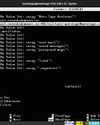FREE YOUR PHONE!
Linux Format
|March 2023
Lesser-spotted Jonni Bidwell climbs to the top of a 5G mast to extol the benefits of running Linux on your phone.

The mobile device world has become duopolised by two big tech outfits, one fruity and the other Borg-ish. Google's Android runs on an array of mobile hardware, has a Linux kernel, and the core Android Open Source Project (AOSP) is freely licensed. Devices can generally be unlocked and custom apps can be sideloaded. Compare it with Apple's walled-garden, locked-down hardware approach in iOS, and you can see why free software advocates might prefer to side with the Android camp. But this argument is specious, because much of Android proper is proprietary.
The Google apps and most of the popular Android apps are all proprietary, and many rely on the fiendish Google Play Services library to do their work (or display ads). Those apps all collect data and tie it to your Google account. Despite new privacy controls, permissions and supposedly easier-to-understand license agreements, it's difficult to comprehend what is being shared and how it's used. This has led to an orthogonal argument, that Apple (a fashion brand that makes hardware) cares more about protecting privacy than Google (an ad company).
We're not here to settle arguments, though. We're here to show you another way. How to take back your privacy. How to keep old hardware no longer supported by Android ticking along. To that end, we'll look at installing LineageOS, the most popular AOSP derivative. Next, we'll explore running 'pure' Linux in the form of UBports and PostmarketOS. If you'd rather not install a whole new OS, there are plenty of less risky measures you can take. Read on.

The issue with Android
Android is a hodge-podge of free and proprietary components.
Diese Geschichte stammt aus der March 2023-Ausgabe von Linux Format.
Abonnieren Sie Magzter GOLD, um auf Tausende kuratierter Premium-Geschichten und über 9.000 Zeitschriften und Zeitungen zuzugreifen.
Sie sind bereits Abonnent? Anmelden
WEITERE GESCHICHTEN VON Linux Format

Linux Format
Create your first WebSocket service
Mihalis Tsoukalos explains how to use the Go programming language to work with the WebSocket protocol.
9 mins
April 2023

Linux Format
Fantastic Mr Firefox
Nick Peers takes a trip down memory lane to reveal the story behind the rise - and slight fall - of Mozilla's popular web browser.
9 mins
April 2023

Linux Format
Set up your terminal and email like it's 1983
Jump in the hot terminal time machine with Mats Tage Axelsson who emails from the command line using the latest technology.
8 mins
April 2023

Linux Format
Universal layer text effects with GIMP
Posters use them, films and presentations are hard to imagine without them: text effects. Attract attention with Karsten Günther and GIMP.
8 mins
April 2023

Linux Format
Jump to a federated social network
Nick Peers reveals how you can get up and running with this free, decentralised and non-profit alternative to Twitter.
9 mins
April 2023

Linux Format
Free our SOFTWARE!
Taking anything for granted is dangerous, so Jonni Bidwell and Mike Saunders revisit how the free software movement got started to help free us from proprietary tyranny!
4 mins
April 2023

Linux Format
Master RPI.GPIO
Les Pounder goes back to the early days of the Raspberry Pi - and his career with this classic library! -
5 mins
April 2023

Linux Format
Waveshare Zero to Pi3
Transform your Pi Zero into a Pi 3, they promised Les Pounder, but it's more like adding on go-faster stripes.
2 mins
April 2023

Linux Format
The Best OPEN SOURCE Software Ever!
In an attempt to trigger controversy, Michael Reed and Neil Mohr unequivocally state these are the greatest free software apps ever. Probably. We’re just trying to be helpful.
19 mins
April 2023

Linux Format
Linux-Mandrake 7
Simplicity and a wide range of applications make this a great distribution for all Linux users.
2 mins
April 2023
Translate
Change font size

